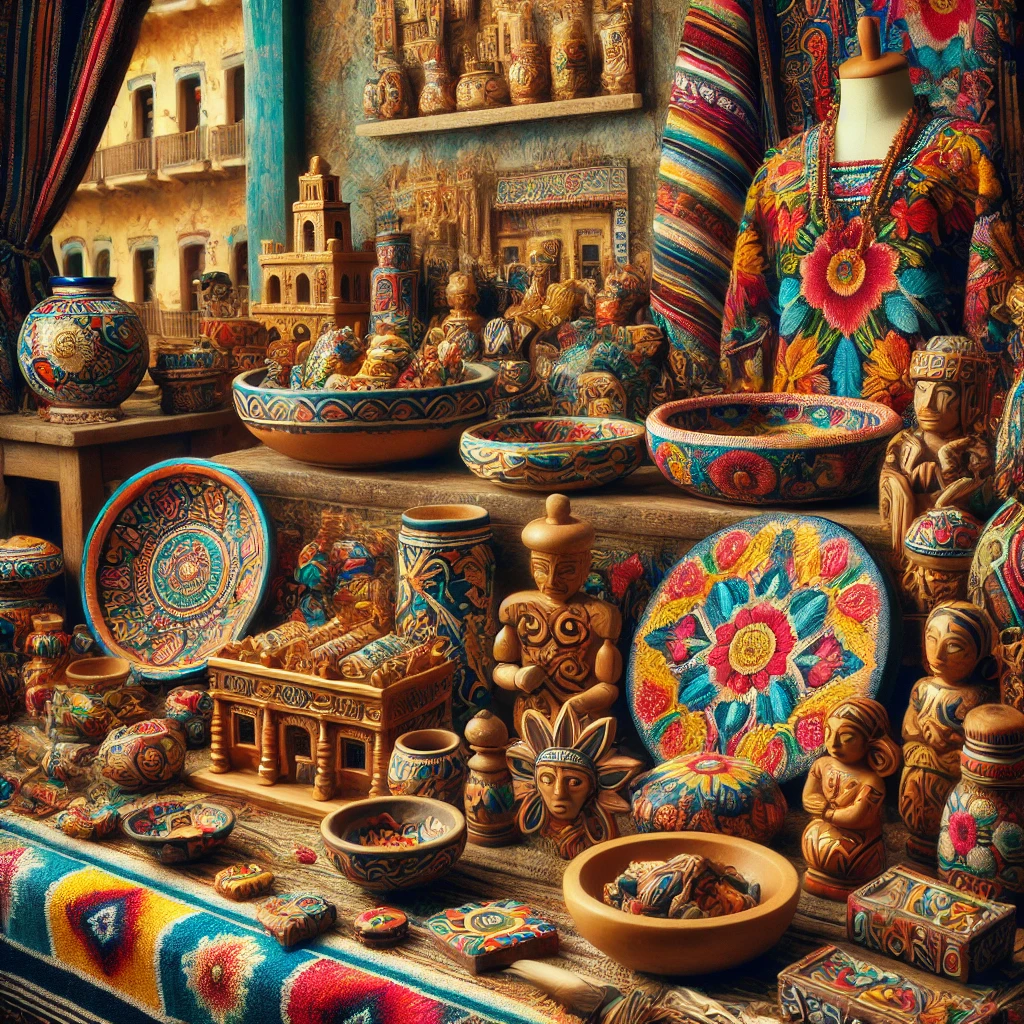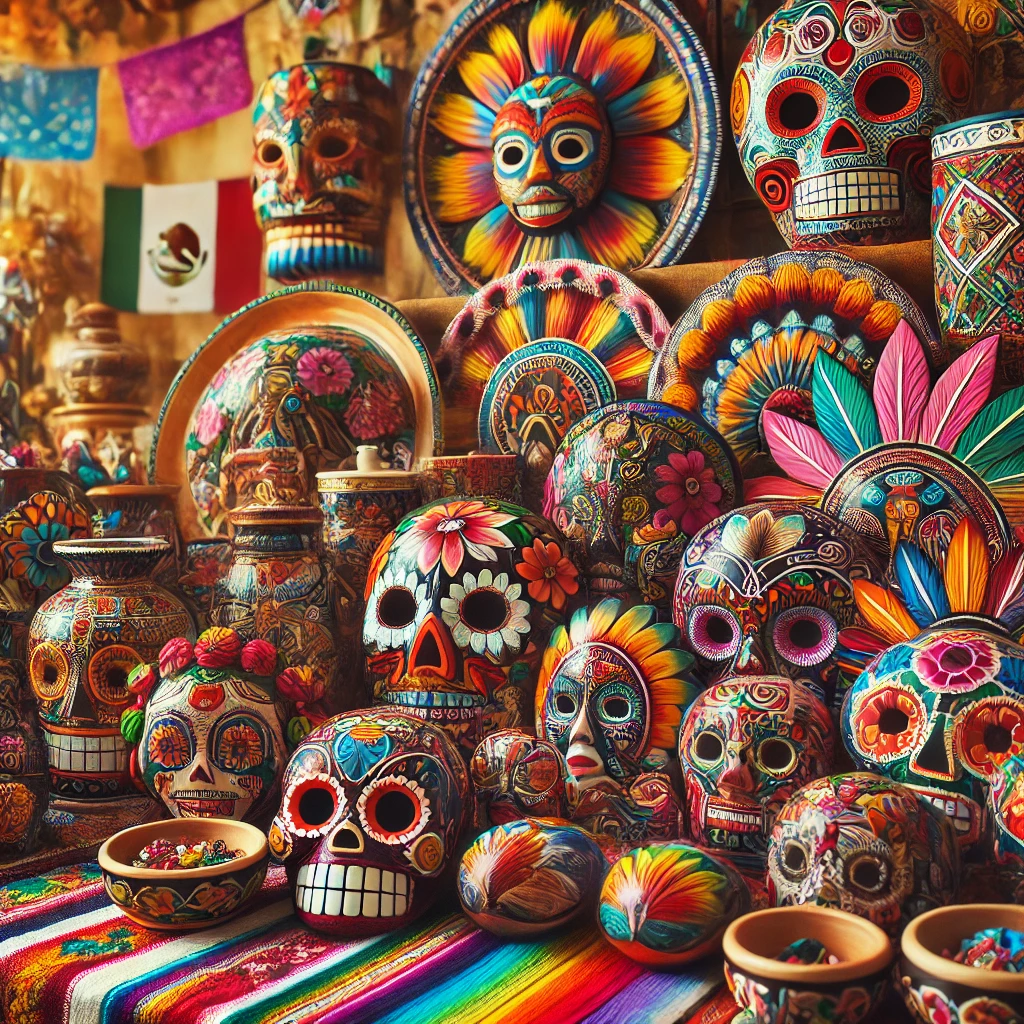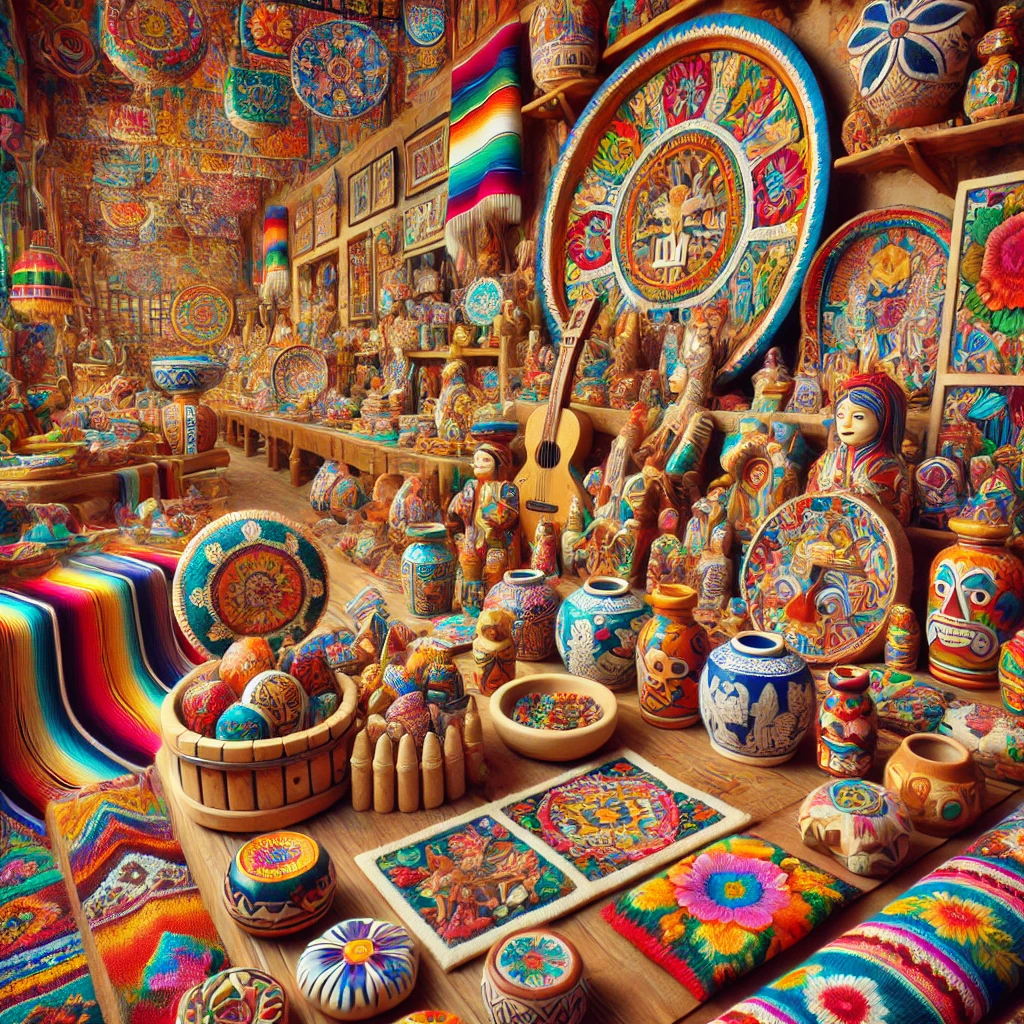Table of Contents
Introduction to Mexican Folk Art
Mexican folk art is a vibrant and diverse expression of the country’s rich cultural heritage, encompassing an array of artistic practices that reflect the historical and social nuances of Mexico. This form of artistry includes a wide range of crafts, such as pottery, weaving, woodcarving, and more, often infused with personal and collective narratives that speak to the experiences of the communities that create them. The uniqueness of Mexican folk art lies in its ability to merge indigenous traditions with colonial influences, ultimately resulting in a distinctive creative language that resonates with both local and global audiences.
The significance of folk art in Mexican culture cannot be understated; it serves as a visual representation of the identity and values of Mexican society. Each piece of folk art can be seen as a testament to the craftsmanship and dedication of the artisan, carrying forward techniques and styles that have been passed down through generations. By integrating elements from various historical epochs, such as pre-Hispanic traditions, the colonial period, and contemporary movements, Mexican folk art has evolved into a complex tapestry that embodies the nation’s multifaceted identity.

This fusion of influences is evident in many art forms, ranging from the intricate designs of Talavera pottery to the colorful papel picado decorations that celebrate significant life events. These crafted items not only hold aesthetic value but also convey cultural stories and spiritual meanings. As we delve deeper into the world of Mexican folk art, we will uncover the intricate details that mark its significance, the artists who keep these traditions alive, and the myriad ways in which this artistry continues to inspire and celebrate the essence of Mexican culture.
Key Characteristics of Mexican Folk Art
Mexican folk art is renowned for its vibrant colors and intricate craftsmanship, showcasing a rich cultural heritage that embodies the essence of Mexico’s diverse history. One of the most striking features of this art form is its bold and saturated color palette. Artists often employ an array of hues, reflecting the natural beauty of the Mexican landscape and the spirit of its people. Bright blues, deep reds, warm yellows, and lush greens come together to create stunning visual compositions, evoking emotions and celebrations intrinsic to Mexican life.
Another defining characteristic of Mexican folk art is the intricate patterns and designs that adorn many pieces. These patterns are often inspired by indigenous motifs, flora, and fauna, each telling a unique story that connects the artwork to its origins. The attention to detail is remarkable, as artisans meticulously carve, paint, or weave each element with precision and purpose. In this way, the art serves as a narrative, encapsulating traditions, beliefs, and the day-to-day experiences of the communities from which they originate.
Furthermore, traditional materials play a crucial role in the creation of Mexican folk art. Artisans frequently utilize locally sourced resources such as clay, wood, textiles, and metal, which not only support regional economies but also promote sustainability. For instance, the famous Talavera pottery is made from high-quality clay and often features traditional designs that have been passed down through generations. Similarly, handwoven textiles exemplify the skill and labor that artisans invest in their craft, often incorporating age-old techniques that celebrate cultural heritage.
Ultimately, the vibrant colors, intricate patterns, and use of traditional materials in Mexican folk art are not merely aesthetic choices; they are a reflection of the rich cultural narratives that define Mexico’s artistic landscape. Each piece serves as a testament to the craftsmanship, creativity, and historical significance embedded within this beautiful art form.
Types of Mexican Folk Art: A Diverse Palette
Mexican folk art encapsulates a vibrant array of craftsmanship, reflecting the rich cultural heritage and diverse regional traditions of the country. Among the most revered forms of this art are pottery, textiles, beadwork, and wood carving, each boasting its unique techniques and styles that tell the story of their origins. The diversity in Mexican folk art is not merely aesthetic; it resonates with the historical and social contexts from which these crafts emerge.
Pottery, for instance, is one of the oldest forms of folk art in Mexico. Regions such as Oaxaca are renowned for their distinctive black clay pottery, which reflects a unique firing technique that creates a glossy finish. In contrast, Talavera pottery from Puebla is characterized by its colorful, intricate designs, often depicting flora and fauna. Each region’s style is influenced by local resources and cultural narratives, resulting in a rich tapestry of pottery that appeals to collectors and enthusiasts alike.
Textiles also represent a crucial element of Mexican folk art, with various communities producing exquisite handwoven garments and accessories. For example, the Huichol people are known for their vibrant, intricate designs incorporating symbols with deep cultural meanings. In contrast, the Otomi textiles, often featuring bold colors and patterns, continue to capture the essence of rural life in central Mexico. The use of natural dyes and traditional weaving techniques further enhances the authenticity of these textiles, making them highly sought after.
Similarly, beadwork in Mexico showcases intricate craftsmanship, especially among indigenous groups. This form of art can be seen in jewelry, ornaments, and vibrant decorations. Each beadwork piece often carries cultural significance and is crafted using time-honored techniques passed down through generations. Lastly, wood carving is another vital aspect of Mexican folk art, with artisans showcasing their skills in creating elaborate sculptures and functional items, often inspired by local folklore and religious motifs.
The richness and diversity found in Mexican folk art embody a remarkable fusion of history, culture, and artistic expression. Each category offers a glimpse into the lives and traditions of the communities that create them, celebrating the unique characteristics and craftsmanship that define this vibrant art form.
The Role of Folk Art in Mexican Culture
Folk art is an integral component of Mexican culture, encompassing a broad range of artistic expressions that reflect the nation’s rich history and diverse traditions. More than merely decorative, folk art serves as a vital cultural narrative, presenting stories and beliefs that have been passed down through generations. This narrative framework is essential for the preservation and celebration of cultural identity, making folk art an essential vehicle for the expression of community values and shared experiences.
Throughout Mexico, folk art regularly features in various community celebrations and rituals. Different regions boast unique crafts that embody local characteristics, such as pottery from Oaxaca, textiles from Chiapas, or wooden carvings from Puebla. These art forms are often employed during significant events, including weddings, religious festivities, and seasonal celebrations, thus reinforcing social bonds among community members. By participating in the creation and display of folk art, individuals engage in communal identity, fostering a sense of belonging and cultural pride.
Religious rituals also heavily incorporate folk art, often bridging the spiritual world and everyday life. For instance, the colorful papel picado, a decorative paper cut-out often used during Día de los Muertos, demonstrates how art is intertwined with spirituality and remembrance. This affinity for folk art in sacred contexts enhances its role as a means of cultural celebration and preservation, highlighting the connections between tradition and contemporary practices.
Moreover, beyond its aesthetic and functional elements, folk art acts as a narrative tool. Artists often convey personal, social, and political commentary through their work, painting a vivid picture of the community’s collective consciousness. Thus, the role of folk art transcends mere decoration; it is a vital expression of cultural heritage and an essential instrument for cultural continuity within Mexican society.
Celebrating Artisans: The Masters Behind the Craft
The vibrant tapestry of Mexican folk art is woven by the hands of skilled artisans who dedicate their lives to the preservation and expression of their cultural heritage. These craftspeople are not merely creators; they are storytellers, transmitting age-old traditions through their artistry. Each artisan has a unique narrative that intertwines with their craft, providing a glimpse into their dedication, challenges, and the vibrancy of Mexican culture.
Often, artisans work within familial communities where techniques and secrets are passed down through generations. For instance, the intricate designs of Oaxacan wood carvings are not just products of individual talent but rather reflections of collective heritage. Artisans such as Rufino Tamayo have gained recognition not only for their craftsmanship but also for their commitment to fostering knowledge among younger generations. Much of their work encompasses storytelling, where each piece embodies narratives that are pivotal to their community’s identity.
Despite their passion and artistry, many artisans face significant challenges. Globalization and mass production threaten traditional methods and economic stability. With cheaper, machine-made alternatives flooding the market, artisans often struggle to maintain their livelihood. Moreover, the intricate and time-consuming nature of folk art means their creations often carry a price point that is not easily accessible to all consumers. This situation underscores the importance of supporting local artisans, as they are vital to the survival of Mexican folk art.
In light of these challenges, organizations and initiatives are emerging to promote artisan work and help sustain their practices. These efforts recognize the need for fair compensation and greater appreciation for the labor that goes into each handcrafted item. By fostering a deeper understanding of these artisans and their crafts, we can ensure that the rich legacy of Mexican folk art continues to thrive for future generations.
Modern Interpretations of Folk Art
In recent years, contemporary artists in Mexico have been successfully reinterpreting traditional folk art forms, creating a vibrant dialogue between the past and the present. This reimagining of folk art is characterized by innovative techniques and themes that resonate with today’s societal and cultural challenges. Artists are embracing a variety of mediums, including painting, sculpture, textile design, and digital art, which has helped to breathe new life into age-old practices.
One notable aspect of modern folk art interpretations is the fusion of traditional craftsmanship with contemporary aesthetics. For instance, artists utilize age-old methods such as ceramic glazing and weaving while integrating modern design principles and materials. This change not only preserves traditional techniques but also makes them relevant to a younger audience. By merging these elements, artists are able to communicate powerful messages that reflect contemporary social issues, identity, and environmental concerns.
Furthermore, the themes explored in today’s folk art often shift from purely decorative to more narrative-driven pieces. Many artists delve into personal and collective histories, addressing topics such as migration, identity, and community, which resonate strongly within modern society. This narrative approach fosters a connection between the artwork and the viewer, emphasizing the continued relevance of folk art as a medium for storytelling and cultural expression.
The revival of interest in folk art among younger generations can also be attributed to increased accessibility. The advent of social media platforms allows artists to showcase their work to a global audience, sparking international interest in Mexican folk art traditions. Innovative exhibitions that incorporate technology and interactive elements further engage the public, inviting them to experience the colorful world of folk art in new and exciting ways. Through these modern interpretations, Mexican folk art continues to thrive, bridging generations and cultures alike.
The Influence of Mexican Folk Art Worldwide
Mexican folk art, characterized by vibrant colors and intricate craftsmanship, has made a profound impact beyond its geographical origins. Artists and artisans from various cultures have drawn inspiration from these traditional forms, leading to a fusion of styles that celebrates both the uniqueness of Mexican heritage and broader artistic expressions. The international community is increasingly recognizing the importance of these cultural artifacts, exemplifying their relevance in contemporary art.
Global art scenes are often enriched by exhibitions featuring Mexican folk art. Notable events, such as the Oaxaca Exhibit in New York, have showcased these traditional pieces on a larger stage, captivating audiences with their stories and artistry. These exhibitions not only highlight the beauty of Mexican craftsmanship, but they also facilitate cross-cultural dialogue, allowing international artists to explore folk themes that transcend borders. The integration of Mexican folk art elements into modern art movements reflects a shared appreciation for cultural heritage, fostering unity through creativity.
Collaborations between Mexican artisans and international artists have led to innovative projects that merge traditional techniques with contemporary designs. These partnerships showcase the adaptability of folk art, illustrating how it can evolve while maintaining its rich cultural narratives. For instance, the use of traditional textile patterns in fashion design has gained prominence, with designers around the world incorporating these elements into their collections, further popularizing Mexican artistry.
In various art forms, including ceramics, painting, and sculpture, the influence of Mexican folk art is evident. Its motifs, colors, and themes resonate across different mediums, inspiring a new generation of artists. Through these diverse global interactions, Mexican folk art continues its journey, enriching the international art landscape and ensuring that the craftsmanship behind these creations is celebrated and preserved.
Preserving Folk Art Traditions
Folk art traditions are a vital component of cultural identity, particularly within the diverse communities of Mexico. These art forms, which include pottery, textiles, and woodwork, not only express the unique aesthetics of different regions but also reflect the historical narratives and social contexts of their origins. However, the challenges posed by globalization have threatened the survival of these traditions. As modern influences permeate all aspects of society, preserving the authenticity and significance of folk art becomes increasingly critical.
In recent years, various local communities and organizations have undertaken initiatives to sustain and promote folk art traditions. These efforts aim to ensure that future generations can appreciate and maintain the artistry that has been passed down through centuries. Craft workshops, educational programs, and cultural festivals are being organized to engage younger audiences and encourage them to participate in these time-honored practices.
Additionally, partnerships between artisans and development institutions have emerged, providing resources to enhance the quality and visibility of traditional crafts. By fostering collaboration, these entities are able to create platforms for artisans to showcase their work, thus elevating their status in a global market. Furthermore, there is a concerted effort to document and archiving these practices, capturing the stories behind each piece of art. This not only helps to preserve the techniques used but also reinforces the cultural significance of the crafts.
Moreover, digital platforms are playing an increasingly important role in the preservation of folk art traditions. By utilizing social media and e-commerce, artisans can reach broader audiences, enabling them to share their stories and sell their creations without the constraints of geographical limitations. This exposure can foster appreciation and ensure that folk art traditions remain relevant in contemporary society.
Through these collective efforts, there is hope for the continued vitality of folk art traditions. By investing in the knowledge and skills associated with these crafts, communities can ensure that their rich heritage is cherished and passed on to future generations.
Conclusion: Embracing the Vibrancy of Mexican Folk Art
In reflecting upon the multifaceted realm of Mexican folk art, it becomes evident that this vibrant tradition plays a crucial role in the cultural landscape of Mexico. The intricate craftsmanship and the passionate creativity displayed through various artistic expressions highlight not only the immense talent of the artists but also the rich history and values embedded within each piece. From colorful textiles to ornamental pottery, every creation tells a story rooted in local customs and communal heritage.
It is essential to recognize the importance of preserving these art forms as they represent the collective memory of communities and contribute to the national identity. By embracing the vibrancy of Mexican folk art, we not only celebrate its aesthetics but also acknowledge the diverse narratives that shape its existence. Each artwork is a reflection of the socio-economic conditions, spiritual beliefs, and regional characteristics that define Mexican culture. Thus, folk art deserves our attention and respect, as it encapsulates the spirit of its people.

As enthusiasts of culture and creativity, we are encouraged to actively engage with and support the artisans who dedicate themselves to this craft. Purchasing authentic handcrafted items, attending local exhibitions, or participating in workshops are practical ways to appreciate and promote the continuity of these traditions. By doing so, we contribute to the sustainability of their unique skills and encourage a new generation of artists to thrive. Understanding and celebrating Mexican folk art fosters a deeper appreciation for its significance, ensuring that the radiant hues and intricate designs continue to resonate with people around the globe.





